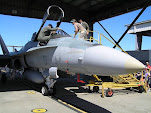The Government is making several excuses as to why they are retiring the F111, yet a bit of research will prove that these are entirely excuses aimed at political shortcomings. The F111 provides Australia will unprecedented capability
Dr Kopp goes on to say "Premature retirement of the F-111 will leave the RAAF with an unprecedented capability gap in the air strike roles, of the order of 50% against the strike capability planned for in the 2000 White Paper. Assertions that the F-111 aircraft are no longer supportable either economically or technically are simply not true."
And then he makes the point that it is far more economical to keep the existing F111s and maintain them along with a buy of the F22s instead of the ill-fated JSF F35s.
Read it all.
Information on the F15 is available here, here, and here. It is certainly not the F22 (it will take quite some time to acquire the F22 anyway) but is better than nothing. If the Government wanted to be scapegoats then get us some F4 Phantoms which are currently still in service. They are a mighty fine aircraft. It is better having some form of Air Power than none at all. But saying that is not helpful when in 1941 and 1942 Wirraways went up against Zeros. None of our Air Force pilots wants to be told to fly suicide missions and we shouldn't expect them to. Our Government should learn from the lack of Air Force equipment available in World War II to us.


The Hornet is two engined fighter. Australia bought 75 of them. Because of the size of Australia's Air Force we should have bought F15s since the Hornets aren't really able to go very far. They have a range (ferry) of 1800nm whereas the F15 has a ferry range of 3000nm. A few other factors make the F15 the best aircraft when it is put up against the F/A18.

2 comments:
F-15s grounded in America due to a structural flaw. http://www.americafront.com/url.php?id=64421
However the super hornet buy is still a spectacular waste and its motivation should be looked into.
The F-15s which are grounded in America are more than 20 years old. I would think that buying new F-15s would be the answer and ensure a solution to the current flaw which has grounded the F-15C. Australia would buy the F-15AU, similar to Korea's and Singapore's NEW acquisition of the world's No 1 Air Superiority Fighter (excepting the F22).
And being able to fly alongside the F111s unlike the F/A-18s, it would boost Australia's survivability in deep strike operations.
I agree that the Super Hornet is a spectacular waste as well.
I don't know if anyone can solve the current defence mistakes in the US and Australia as we are so reliant on technology and many different contractors making parts. I suppose if you wanted to build something better, you would make all the parts for it in the same location, under a new security act (law). This would do a lot to solve the problems, but with this comes huge expense. Who is going to foot the bill?
I would suggest going down this path would be ideal to building something right and getting the mistakes/problems sorted early and fast.
Many different private contractors make it extremely difficult in logistics alone. Look at the A380, this is a prime example.
Post a Comment